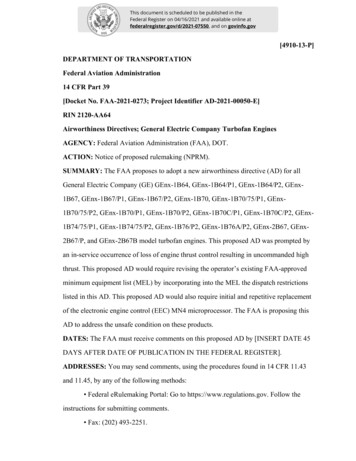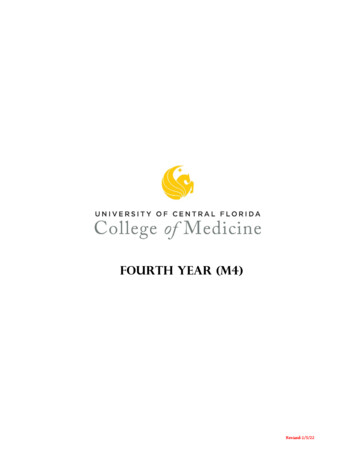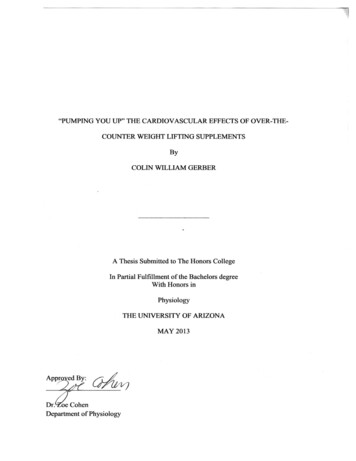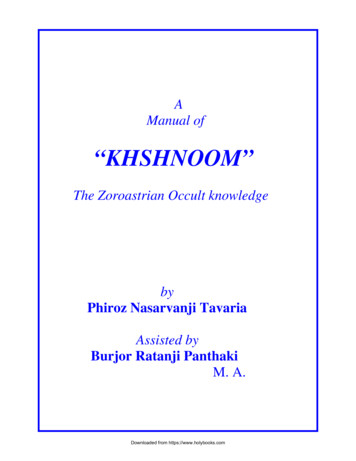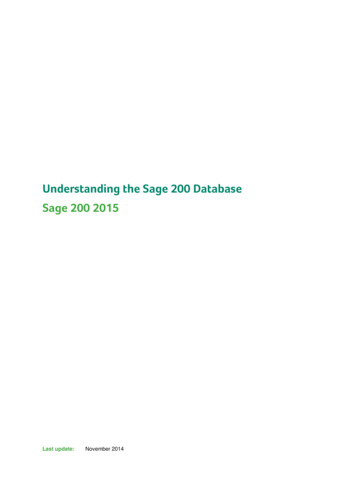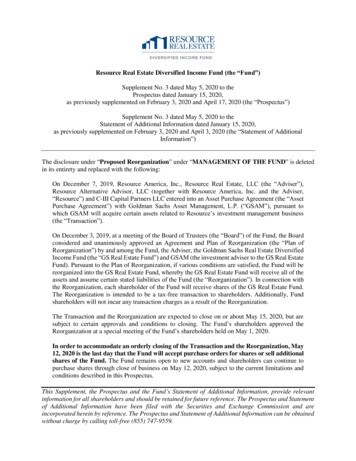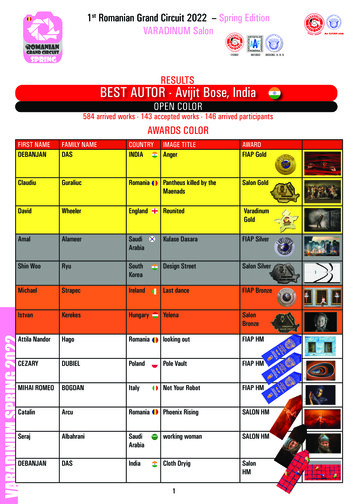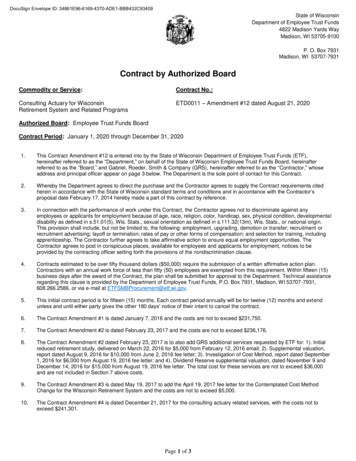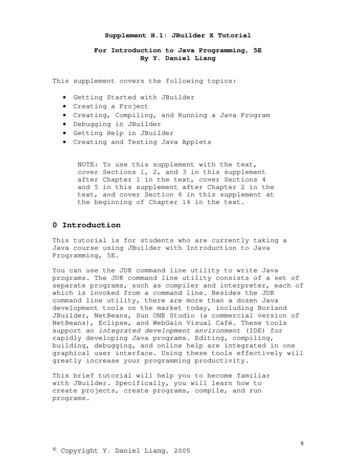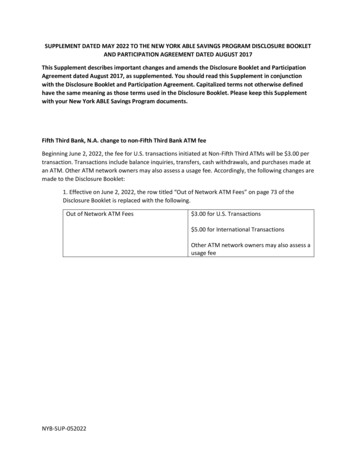
Transcription
SUPPLEMENT DATED MAY 2022 TO THE NEW YORK ABLE SAVINGS PROGRAM DISCLOSURE BOOKLETAND PARTICIPATION AGREEMENT DATED AUGUST 2017This Supplement describes important changes and amends the Disclosure Booklet and ParticipationAgreement dated August 2017, as supplemented. You should read this Supplement in conjunctionwith the Disclosure Booklet and Participation Agreement. Capitalized terms not otherwise definedhave the same meaning as those terms used in the Disclosure Booklet. Please keep this Supplementwith your New York ABLE Savings Program documents.Fifth Third Bank, N.A. change to non-Fifth Third Bank ATM feeBeginning June 2, 2022, the fee for U.S. transactions initiated at Non-Fifth Third ATMs will be 3.00 pertransaction. Transactions include balance inquiries, transfers, cash withdrawals, and purchases made atan ATM. Other ATM network owners may also assess a usage fee. Accordingly, the following changes aremade to the Disclosure Booklet:1. Effective on June 2, 2022, the row titled “Out of Network ATM Fees” on page 73 of theDisclosure Booklet is replaced with the following.Out of Network ATM Fees 3.00 for U.S. Transactions 5.00 for International TransactionsOther ATM network owners may also assess ausage feeNYB-SUP-052022
SUPPLEMENT DATED JANUARY 2022 TO THE NEW YORK ABLE SAVINGS PROGRAMDISCLOSURE BOOKLET AND PARTICIPATION AGREEMENT DATED AUGUST 2017This Supplement describes important changes and amends the Disclosure Booklet andParticipation Agreement dated August 2017, as supplemented. You should read this Supplementin conjunction with the Disclosure Booklet and Participation Agreement. Capitalized terms nototherwise defined have the same meaning as those terms used in the Disclosure Booklet. Pleasekeep this Supplement with your New York ABLE Savings Program documents.Increase to Annual Contribution Limit and Federal Annual Gift Tax Exclusion.The Annual Contribution Limit for contributions to NY ABLE is tied to the annual federal gift tax exclusionamount. Effective January 1, 2022, the annual federal gift tax exclusion has increased to 16,000 perdonee. Therefore, also effective January 1, 2022, the Annual Contribution Limit for contributions to NYABLE has increased to 16,000 per year. All references to the Annual Contribution Limit and annualfederal gift tax exclusion in the Disclosure Booklet and Participation Agreement are hereby revised toreflect these increases as follows:1.The following replaces the question “What is the maximum allowable contribution to a NYABLE Account?” and answer on page 8 of the Disclosure Booklet:What is the maximum allowable contribution to a NY ABLE Account?Account Owners with no earned income may contribute, or others may contribute for their benefit, upto 16,000 per year to an ABLE account. Once this annual limit is reached, no further contributions maybe made until the start of the next calendar year. An Account Owner who is employed may makecontributions in excess of the annual limit, subject to certain restrictions. See “Annual ContributionLimit” on page 26 for more information. In addition, the Maximum Account Balance allowed under NYABLE is 520,000.2.The following replaces the paragraph entitled “Annual Contribution Limit” beginning on page 26of the Disclosure Booklet:Annual Contribution Limit. Section 529A sets an annual contribution limit for Qualified ABLE Programs.NY ABLE’s Annual Contribution Limit is currently 16,000 per Account from all sources, unless theAccount Owner is employed and earns income, in which case the Account Owner may be eligible tomake additional contributions, as described later in this section. For example, if an Account Owner whodoes not earn income contributes 8,000 to the Account in a calendar year and the Account Owner’sparents contribute 8,000 in the same calendar year, the Annual Contribution Limit would be reachedand no additional contributions would be accepted into the Account until the following year. ThisAnnual Contribution Limit may increase from time to time.In addition to the 16,000 Annual Contribution Limit, an Account Owner who is employed may alsocontribute annually the lesser of: an amount equal to the Account Owner’s compensation includible in the Account Owner’s grossincome for the taxable year, or the amount equal to the poverty line for a one-person household for the preceding calendaryear ( 12,880 for 2021) which is the excess an Account Owner can contribute in the 20221
calendar year. This amount is generally updated annually by the U.S. Department of Health andHuman Services,as long as there were no contributions made for the taxable year with respect to the Account Owner to a defined contribution plan (within the meaning of Section 414(i) of the Code), with respect towhich the requirements of Section 401(a) or 403(a) are met, a tax sheltered annuity plan within the meaning of Section 403(b) of the Code, and an eligible deferred compensation plan described in Section 457(b) of the Code.It is your responsibility to maintain adequate records to ensure that you do not exceed the limit. Youshould consult your tax advisor before making an increase in your contributions.Please note that balances exceeding 100,000 could affect your eligibility for SSI under title XVI of theSocial Security Act. See Section 14. Supplemental Security Income Guidance, for more information.3.The following replaces the information in the call out box on page 27:The Annual Contribution Limit for NY ABLE is currently 16,000. A total account balance exceeding 100,000 could affect your SSI eligibility.4.The following replaces paragraph 1. under the heading “The Proposed Regulations also providethat a Qualified ABLE Program” on page 45:1. must return contributions to an Account in excess of the Annual Contribution Limit (ExcessContributions) to the contributor, along with all net income attributable to those ExcessContributions;The following replaces the paragraph under the heading “Federal Gift/GST Tax” on page 46:Federal Gift/GST TaxFor federal gift and GST tax purposes, contributions to your Account by you are not considered to becompleted gifts because you cannot make a transfer of property to yourself, and a transfer of propertyis a fundamental requirement for a completed gift. However, contributions to your Account by personsother than yourself are considered a completed gift from the contributor to you and are eligible for theannual gift tax exclusion. Contributions that qualify for the annual gift tax exclusion are generally alsoexcludible for purposes of the federal GST tax. A donor’s total contributions to your Account in any givenyear (together with any other gifts made by the donor to you in the year) will not be considered taxablegifts and will generally be excludible for purposes of the GST tax if the gifts do not in total exceed theannual exclusion for the year. Currently, the annual exclusion is 16,000 per donee. This means that ineach calendar year a person may contribute up to 16,000 to your Account without the contributionbeing considered a taxable gift, if that person makes no other gifts to you in the same year. The annualexclusion is indexed for inflation and therefore is expected to increase over time.The following replaces the paragraph entitled “Annual Contribution Limit” on page 61:Annual Contribution Limit: Under Section 529A the annual contribution limit for Qualified ABLEPrograms is currently 16,000 per Account from all sources, except that an Account Owner who is2
employed may be eligible to contribute additional amounts. See “Annual Contribution Limit” on page 26for more information.Increase to Creditor Protection under U.S LawsEffective April 1, 2022, the following replaces the section entitled “Creditor Protection under U.S. Laws”beginning on page 56 of the Disclosure Booklet:Creditor Protection under U.S. LawsFederal law expressly excludes certain funds from an individual debtor’s bankruptcy estate (which funds,therefore, will not be available for withdrawal to such individual’s creditors), if the funds werecontributed by the debtor to an Account. The bankruptcy protection for Code Section 529A accounts,however, is limited.The funds contributed to an Account will be protected if the Account Owner is the individual debtor’schild, stepchild, grandchild, or step grandchild for the taxable year in which the funds were placed in theAccount, and only to the extent that such funds are not (i) pledged or promised to any entity inconnection with any extension of credit; or (ii) Excess Contributions. The following limits also apply: Contributions made to an Account Owner’s Account more than 720 days before a federalbankruptcy filing are completely protected; Contributions made to an Account Owner’s Account during the period beginning 365 daysthrough 720 days before a federal bankruptcy filing are protected up to 6,825; and Contributions made to an Account Owner’s Account less than 365 days before a federalbankruptcy filing are not protected against creditor claims in federal bankruptcy proceedings.Your own state law may offer additional creditor protections. You should consult your legal advisorregarding the effect of any bankruptcy filing on the Account.3
SUPPLEMENT DATED OCTOBER 2021 TO THE NEW YORK ABLE SAVINGS PROGRAMDISCLOSURE BOOKLET AND PARTICIPATION AGREEMENT DATED AUGUST 2017This Supplement describes important changes and amends the Disclosure Booklet andParticipation Agreement dated August 2017, as supplemented. You should read this Supplementin conjunction with the Disclosure Booklet and Participation Agreement. Capitalized terms nototherwise defined have the same meaning as those terms used in the Disclosure Booklet. Pleasekeep this Supplement with your New York ABLE Savings Program documents.FIFTH THIRD CHANGE TO OVERDRAFT CALCULATIONOn December 8, 2021, Fifth Third Bank is changing the posting order of non-time-stamped debits. Other debits will beprocessed in order from the smallest to the largest amount. Accordingly, the following changes are made to theDisclosure Booklet:1. Effective on December 8, 2021, the row entitled “Overdraft Calculation Order” on page 74 of the Disclosure Booklet is replacedwith the following. This section also replaces the Fifth Third Bank change to overdraft calculation information found in the March2020 Supplement:Overdraft Calculation OrderDaily Balance From Prior Business DayIf there is not enough money in your account at the end of theday to cover all of your posted debits, then we considertransactions in this order.( ) Add credits.(-) Subtract time-stamped debits(-) Subtract other debits (e.g., checks, Internet bill payment).(-) Subtract Bank fees and service charges (e.g., monthlyservice charge).Please see Overdraft Calculation Order section within thisAppendix A for more details.2. Effective on December 8, 2021, the table entitled “Overdraft Calculation Order” on page 78 of the Disclosure Booklet is replacedwith the following. This section also replaces the Fifth Third Bank change to overdraft calculation information found in the March2020 Supplement:Overdraft Calculation OrderIf there is not enough money in your checking account at the end of the day to cover all of your posted debits (‐), then we considertransactions in the following order:FIRSTExamples of credits ( ) may include:Add in credits ( ) Contributions Refunds Returned Items
SECONDSubtract time-stampeddebits (-)Time-stamped debits generally are debits that are authorized at the time the transaction is madeand are later presented to us for payment. These debits appear in your account as pendingtransactions until they are posted. Time-stamped debits include: ATM withdrawals One-time debit card purchasesTime-stamped debits are posted in chronological order.THIRDSubtract other debits (-)All other debits that are not categorized as time-stamped debits (above) or Bank fees (below) arein this category, which includes: Checks written Outgoing ACH transfers (automatic bill payments) Outgoing wire transfersThese other debits are posted from smallest to largest dollar amount.FOURTHSubtract Bank fees andservice charges (-)Fifth Third Bank’s fees and service charges are subtracted last.
SUPPLEMENT DATED JULY 2021 TO THE NEW YORK ABLE SAVINGS PROGRAMDISCLOSURE BOOKLET AND PARTICIPATION AGREEMENT DATED AUGUST 2017This Supplement describes important changes and amends the Disclosure Booklet andParticipation Agreement dated August 2017, as supplemented. You should read this Supplementin conjunction with the Disclosure Booklet and Participation Agreement. Capitalized terms nototherwise defined have the same meaning as those terms used in the Disclosure Booklet. Pleasekeep this Supplement with your New York ABLE Savings Program documents.PERFORMANCE UPDATE1.The following replaces “Section 6. Performance” on page 42 of the Disclosure Booklet:Section 6. PerformanceThis table shows how the performance of the Investment Options has varied over the periods listed.Theperformance data includes each Investment Option’s total annual asset-based fee, but does not include othercharges associated with an investment in NY ABLE. See Your Investment Costs on page 10. The performance of theInvestment Options will differ from the performance of the Underlying Funds. See Differences betweenPerformance of the Investment Options and Underlying Funds on page 41.Your personal performance may be different than the performance shown. This performance data shownrepresents past performance, which is not a guarantee of future results. Investment returns and principal valuewill fluctuate, so your Units, when sold, may be worth more or less than their original cost. Current performancemay be lower or higher than the performance data cited. For performance data current to the most recentmonth-end, visit www.mynyable.org.Average Annual Total Returns as of March 31, 20211INVESTMENT OPTION11 YEAR3 YEARSINCE INCEPTIONINCEPTION DATEAggressive Option48.87%11.95%12.07%8/10/2017Moderate Option33.33%9.68%9.51%8/10/2017Intermediate Option19.26%6.73%6.49%8/10/2017Conservative Option8.42%4.06%3.82%8/10/20171The returns are net of asset-based fees. However, the Quarterly Account Maintenance Fee of 13.75 charged to eachAccount is not reflected in the performance data. The fee is discounted by 2.50 if you elect electronic deliverynotification for statements and confirmations.MANAGEMENT AGREEMENT EXTENSION2.The following replaces the second paragraph under the heading “Potential Changes to the Program,Program Manager, and Investment Manager” on page 16 of the Disclosure Booklet:Under New York State law, the Comptroller must solicit competitive bids for a new Program Manager whoseappointment would be effective at the scheduled termination of the current Management Agreement withAscensus Broker Dealer Services, LLC, in May 2023. In certain circumstances Ascensus Broker Dealer Services, LLC,NYB-SUPP-070121
may cease to be the Program Manager, or Vanguard may cease to be the Investment Manager, before thescheduled termination date—e.g., due to a material breach of the Management Agreement by Ascensus BrokerDealer Services, LLC.3.The following replaces the heading entitled “The Program Manager” on page 58 of the Disclosure Booklet:The Program Manager. Ascensus Broker Dealer Services, LLC, serves as the Program Manager of NY ABLE. TheProgram Manager has entered into a Management Agreement with the Comptroller to offer program services to NYABLE. The Program Manager and its affiliates are responsible for the day-to-day operations of NY ABLE, includingrecordkeeping, investment advisory and administrative services. The Management Agreement expires May 6, 2023unless earlier terminated.NYB-SUPP-070121
SUPPLEMENT DATED MARCH 2020 TO THE NEW YORK ABLE SAVINGS PROGRAMDISCLOSURE BOOKLET AND PARTICIPATION AGREEMENT DATED AUGUST 2017This Supplement describes important changes and amends the Disclosure Booklet andParticipation Agreement dated August 2017, as supplemented. You should read this Supplementin conjunction with the Disclosure Booklet and Participation Agreement. Capitalized terms nototherwise defined have the same meaning as those terms used in the Disclosure Booklet. Pleasekeep this Supplement with your New York ABLE Savings Program documents.FEDERAL & NEW YORK STATE TAX REFORM UPDATEOn December 22, 2017, new federal tax reform legislation, H.R. 1 of the 115th Congress, (the Tax Cuts and Jobs Actof 2017, hereinafter, the “Act”), was signed into law. This Act includes new provisions that allow Qualified TuitionPlan (529 Plan) account owners to roll over 529 Plan assets into ABLE Plan accounts with no federal tax oncontributions or earnings, subject to the annual contribution limit and certain other requirements, beginningJanuary 1, 2018. Unless extended, the federal tax benefits allowed by these provisions will expire after December31, 2025.In addition, the New York State Department of Taxation and Finance has determined that these rollovers are nottaxable events for purposes of New York State taxes.However, you should consult a tax advisor for more information about these new provisions. If you are not a NewYork taxpayer, you should seek guidance from the state in which you pay taxes.REVISIONS TO DISCLOSURE BOOKLET:This Supplement amends specific sections of the Disclosure Booklet as follows:The following replaces the question “What is the maximum allowable contribution to a NY ABLE Account?”, andanswer, on page 8 of the Disclosure Booklet:What is the maximum allowable contribution to a NY ABLE Account?Account Owners with no earned income may contribute, or others may contribute for their benefit, up to 15,000per year to an ABLE Account. Once this annual limit is reached, no further contributions may be made until thestart of the next calendar year. In addition, the Maximum Account Balance allowed under NY ABLE is 520,000. AnAccount Owner who is employed may make contributions in excess of the annual limit, subject to certainrestrictions. See “Annual Contribution Limit” on page 26 for more information.The following replaces the question “Can funds from a 529 College Savings Program be moved into a NY ABLEAccount?”, and answer, on page 9 of the Disclosure Booklet:Can funds from a 529 Plan be moved into a NY ABLE Account?Yes. Transferring funds from a 529 Plan account into an ABLE Account is considered a rollover not subject to federalor New York state taxes and tax penalties, provided that certain requirements are met. The contribution must bemade to an ABLE Account of the beneficiary of the account in the 529 Plan or to an eligible member of the family(as defined in Section 529 of the Code) of such beneficiary within 60 days of the date of the withdrawal. The statetax treatment of these rollovers is determined by each individual state. You should consult a tax advisor prior toinitiating a rollover.The following replaces the second bullet point in the section entitled “Annual Contribution Limit” on page 26 of theDisclosure Booklet, as supplemented by the Supplement Dated July 2018: The amount equal to the poverty line for a one‐person household for the preceding calendar year. Thisamount is generally updated annually by the U.S. Department of Health and Human Services.1
The following replaces the paragraph entitled “Maximum Account Balance” on page 27 of the Disclosure Booklet:Maximum Account Balance. The Maximum Account Balance for a NY ABLE Account is 520,000. You will not bepermitted to make contributions to your Account if the Account balance, including the proposed contributions, wouldexceed the Maximum Account Balance. Accounts that have reached the Maximum Account Balance may continue toaccrue earnings, but additional contributions will not be accepted and will be returned or rejected. If, however, themarket value of your Account falls below the Maximum Account Balance due to market fluctuations or as a result ofwithdrawals from your Account, additional contributions will be accepted not in excess of the Maximum AccountBalance. The Program Manager may, in its discretion, refuse to accept a proposed contribution, upon determinationthat acceptance of such proposed contribution would not comply with federal or New York State requirements. TheProgram Administrator will not be responsible for any loss, damage, or expense incurred in connection with a rejectedor returned contribution.The following replaces in its entirety the paragraph under the heading “Coordination with Qualified Tuition Plans”on page 47 of the Disclosure Booklet:Coordination with Qualified Tuition PlansAssets in a qualified tuition plan account under Section 529 generally may be transferred without adverse federal taxconsequences to an ABLE Account for the same beneficiary of the 529 Plan or a member of the family (as defined inSection 529 of the Code) of that beneficiary as long as the contribution is made to an ABLE Account within 60 daysfrom the date of the withdrawal from the 529 Plan account. These rollovers are subject to the annual contributionlimit for ABLE Plan accounts.A rollover that does not meet the criteria of Section 529 of the Code will not be considered a qualified withdrawal forSection 529 purposes and will be subject to federal and applicable state income taxes and the Federal Penalty Tax,except in limited circumstances.NY ABLE must receive a statement issued by the distributing 529 Plan that reflects both the principal and earningsattributable to the rollover amount. Until this documentation is received, the entire amount of the rollovercontribution will be treated as earnings, which is subject to federal and applicable state taxation if you take a Non‐Qualified Withdrawal. Further, the 529 Plan from which you are transferring funds may restrict or prohibit such atransfer of funds or impose charges.The state tax treatment of these rollovers is determined by each individual state. You should consult a tax advisorbefore transferring funds from an account in a 529 Plan to an ABLE Account. Please see Rollovers from 529 Plansunder State Tax Benefits below.The following paragraph is added to the end of the Section titled “State Tax Benefits” on page 47 of the DisclosureBooklet:Rollovers from 529 Plans. Section 529 of the Code allows for rollovers from a 529 Plan account to an ABLEAccount for the 529 Plan beneficiary or a member of the family (as defined in Section 529 of the Code) of the 529Plan beneficiary without federal taxes and tax penalties. In addition, such rollovers will not be subject to New Yorkstate taxes or tax penalties. In order to be tax‐free, such rollovers must meet certain requirements. The state taxtreatment of rollovers is determined by each individual state. You should consult a tax advisor prior to initiating arollover.The following replaces the paragraph entitled “Maximum Account Balance” on page 62 of the Disclosure Booklet:Maximum Account Balance: 520,000. When the fair market value of an Account reaches the Maximum AccountBalance, no additional contributions will be accepted by NY ABLE. However, assets in an Account can continue toaccrue earnings beyond the Maximum Account Balance.2
FEE AND EXPENSE UPDATEThe following replaces, in its entirety, the Fee Structure Table on page 12 of the Disclosure Booklet:Fee Structure TableThe following table describes the Total Annual Asset‐Based Fees and additional expenses for each Investment Option.FEE STRUCTURE TABLEas of December 31, 2019Annual Asset‐Based Fees1Additional ExpensesUnderlyingFund Fee2ProgramManagementFeeTotal AnnualAsset‐BasedFee3Checking OptionQuarterly AccountMonthly Service Fee4 Maintenance FeeAggressive Option0.04%0.36%0.40%N/AModerate Option0.04%0.36%0.40%N/AIntermediate Option0.03%0.37%0.40%N/AConservative Option0.02%0.38%0.40%N/AInvestment OptionPer Account regardlessof which InvestmentOption(s) you choose:Electronic Delivery: 11.25Paper Delivery: 13.75Checking Option1234N/AN/AN/A 2Expressed as an annual percentage of the average daily net assets of each Investment Option.The Estimated Underlying Fund Fee in this column is derived from the expense ratio reported in eachUnderlying Fund’s most recent prospectus and is based on a weighted average of the expenses of theInvestment Option’s Underlying Funds. Fees and expenses of the Underlying Funds may vary.The Total Annual Asset‐Based Fee is assessed against assets over the course of the year. It includes theUnderlying Fund Fee plus the Program Management Fee, but does not include the Quarterly AccountMaintenance Fee.The Checking Option Monthly Service Fee is waived if your Account has an average daily balance over 250or if you are enrolled in electronic statement delivery directly with Fifth Third Bank, National Association.The following replaces the Illustration of Investment Costs Table on page 13 and 14 of the Disclosure Booklet:Illustration of Investment CostsThe following table illustrates the approximate cost of NY ABLE over various periods of time, using the followingassumptions: A 10,000 initial contribution is invested for the time periods shown.A 5% annually compounded rate of return on the amount invested throughout the period.The total funds available in the Account are withdrawn at the end of the period shown to pay for QualifiedDisability Expenses.Expenses for each Investment Option include the maximum Quarterly Account Maintenance Fee of 13.75(i.e., assumes paper delivery of statements and confirms, not electronic delivery).Expenses for the Checking Option include the 2 Monthly Service Fee and do not take into considerationwaivers associated with electronic statement delivery or Account balances over 250.The Total Annual Asset‐Based Fee remains the same as that shown in the Fee Structure Table above.3
The table does not consider the impact of any potential state or federal taxes on the withdrawal nor anypotential state tax deductions or the impact of any service‐based or other fees.This hypothetical is not intended to predict or project investment performance. Past performance is no guarantee offuture results. Your actual cost may be higher or lower.HYPOTHETICAL 10,000 INVESTMENT COST CHARTInvestment Option1 Year3 Year5 Year10 YearAggressive Option 96 293 497 1044Moderate Option 96 293 497 1044Intermediate Option 96 293 497 1044Conservative Option 96 293 497 1044Checking Option 79 237 395 790PERFORMANCE UPDATEThe following replaces Section 6 on page 42 of the Disclosure Booklet:Section 6. PerformanceThis table shows how the performance of the Investment Options has varied over the periods listed. Theperformance data includes each Investment Option’s total annual asset‐based fee, but does not include othercharges associated with an investment in NY ABLE. See Your Investment Costs on page 10. The performance of theInvestment Options will differ from the performance of the Underlying Funds. See Differences betweenPerformance of the Investment Options and Underlying Funds on page 41.Your personal performance may be different than the performance shown. This performance data shownrepresents past performance, which is not a guarantee of future results. Investment returns and principal valuewill fluctuate, so your Units, when sold, may be worth more or less than their original cost. Current performancemay be lower or higher than the performance data cited. For performance data current to the most recent month‐end, visit www.mynyable.org.Average Annual Total Returns as of December 31, 20191INVESTMENT OPTION11 YEARSINCEINCEPTIONAggressive Option24.13%9.79%8/10/2017Moderate Option18.71%7.89%Intermediate Option12.43%5.64%Conservative ON DATE1 T h e returns are net of asset‐based fees. However, the Quarterly Account Maintenance Fee of 13.75 charged to each Account isnot reflected in the performance data. The fee is discounted by 2.50 if you elect electronic delivery notification for statementsand confirmations.4
FIFTH THIRD BANK CHANGING TO FIFTH THIRD BANK, NATIONAL ASSOCIATIONOn November 14, 2019, Fifth Third Bank is changing its name to Fifth Third Bank, National AssociationEffective on November 14, 2019, all references in the Disclosure Booklet and Participation Agreement to “Fifth ThirdBank” are hereby changed to “Fifth Third Bank, National Association.”FIFTH THIRD CHANGE TO OVERDRAFT CALCULATIONOn November 14, 2019, Fifth Third Bank, National Association is changing its method of calculating overdrafts.Pending debit (‐) activity will be included as part of the overdraft calculations at the end of each business day.Pending status indicates the debit (‐) has been authorized but has not posted to your account.Effective on November 14, 2019, the row entitled “Overdraft Calculation Order” on page 74 of the Disclosure Booklet isreplaced with the following:Overdraft Calculation OrderDaily Balance From Prior Business DayIf there is not enough money in your account at the end of theday to cover all of your posted debits, then we considertransactions in this order.( ) Add Credits.(-) Deduct Pending Debits(-) Deduct Posted Time-stamped Debits (i.e., ATM, debit cardpurchases).(-) Deduct Posted Batch Debits (i.e., checks, Internet billpayment).(-) Deduct Fees and Service Charges (i.e., monthly servicecharge).Please see Overdraft Calculation Order section within thisAppendix A for more details.Effective on November 14, 2019, the row entitled “Overdraft Calculation Order” on page 78 of the Disclosure Booklet isreplaced with the following:Overdraft Calculation OrderIf there is not enough money in your checking account at the end of the day to cover all of your posted debits (‐), thenwe consider transactions in the following order:START with your ending Daily Balance from the prior Business Day. This can be found onOnline Banking at 53.com, by reviewing your periodic statement, or by contacting us.FIRSTExamples of credits ( ) may i
Fifth Third Bank, N.A. change to non-Fifth Third Bank ATM fee Beginning June 2, 2022, the fee for U.S. transactions initiated at Non-Fifth Third ATMs will be 3.00 per . Participation Agreement dated August 2017, as supplemented. You should read this Supplement in conjunction with the Disclosure Booklet and Participation Agreement .
